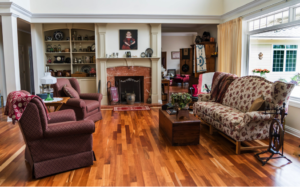Rain, Rain, and More Rain: Five Reasons for Chimney Leaks

Do you suspect that your chimney has been leaking? Read about some common signs of chimney leaks, along with what might be causing your chimney to leak. If you think you may have a problem, schedule an appointment with us, or give us a call at (781) 893-6611. Learn about the signs and causes of chimney leaks:
Signs of a Leaking Chimney
Here are some signs that your chimney may be leaking:
- You hear dripping or see evidence of water droplets
- There is condensation or water inside of your fireplace
- You smell mildew or mold, especially after it rains
- There are water stains on the walls or ceiling near the chimney
- There are water leaks in other areas of your home
- There are white staining on the bricks
- Interior or exterior masonry is cracked or spalled
 Common Causes of a Leaking Chimney
Common Causes of a Leaking Chimney
- Rain Going Straight in from the Top
If you are wondering why your chimney leaks when it rains, chimneys without covers get a lot of rain falling straight down into them. A chimney cover makes sense to most people. Not only does it keep the rain out, but it keeps birds, animals, and debris out. The greatest value of the chimney cover is really keeping everything out that could block the chimney, which can cause CO poisoning. While it’s true that sometimes an uncovered flue can be the source of water problems, most often, the reason for a leak is only when the liner is metal.
- Cracks in the Chimney Crown
The chimney crown is the cement part on top of the chimney. The bricks go up around the tile flue liners, but at the top, you need something to stop the rain and snow from just falling in around the tiles. The very purpose of the chimney crown is to keep the rain out. Cracks in the chimney crown can happen from the shifting of the structure or from shrinkage going back to when the crown was put on. When your crown has cracks, the water goes right through those cracks.
- Chimney Flashing Causes Leaks
Have you ever wondered what is placed around a chimney to prevent leaks? The answer is flashing. The flashing is what keeps water from going into the place where the brick structure comes through the roof. There is a gap between the bricks, and the roof and water will pour through that hole if it’s not sealed up. Flashing is often aluminum that goes in between a couple bricks and bends to go on top of the shingles. Often waterproof material and tar are used to seal those spots. Neither flashing nor tar last forever.
- Bricks Can Seep Water
Bricks and mortar both pass water. The problem is the same as with the crown, the freezing, and thawing all winter with resulting damage, which causes leaks in the house. When water is absorbed into a brick or a mortar joint in the summertime, the water usually dries out after a while. The exceptions would be when that area is in the shade, and those walls stay wet.
- Chimney Leaks That Aren’t Chimney Leaks
Sometimes, a leak starts in a different place but finds its way to the chimney, and then visibly enters the inside of a room at the point of the chimney.
Water could get into the attic or above your ceiling and either drip to the floor or roll along the long piece of wood that spaces out the roof trusses and runs the length of your house, water can travel and even wind up at the chimney.

What to Do
If you observe any signs of chimney leaks, it is best to call a professional to inspect your chimney. At Boston’s Best Chimney, we are experts in every aspect of chimney maintenance and repair. The sooner problems are addressed, the more you can save on potential repairs costs.
Please give us a call at (781) 893-6611 or schedule an appointment here.
